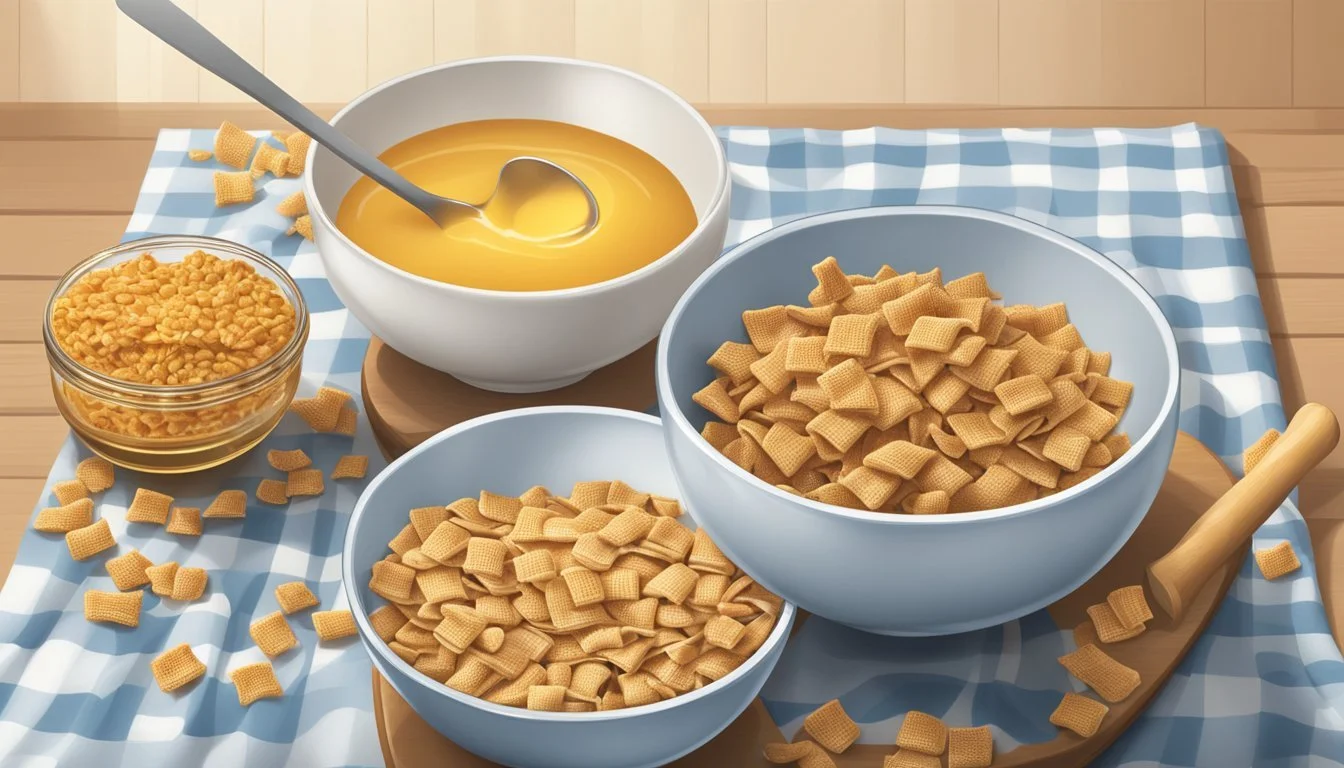Chex vs Honey Smacks
Comparing Nutritional Benefits and Taste
This Article is Part of Our Breakfast Cereal Guide with Details on Chex Nutrition and Honey Smacks Nutrition
When it comes to comparing Chex and Honey Smacks, the battle is both delicious and nutritional. Corn Chex offers 22 grams of complex carbohydrates per serving, significantly more than Honey Smacks' 9 grams, providing a more sustained energy release throughout the day.
In examining the overall health benefits, Chex cereals generally stand out for their higher fiber content, particularly Wheat Chex, which contributes more to daily dietary fiber needs. Honey Smacks, on the other hand, can be high in sugar, contrasting sharply with varieties like Rice Chex which boast 23 grams of complex carbohydrates per serving.
For those focused on managing sodium intake, Cinnamon Chex is notably high in this mineral, which might be a consideration for health-conscious consumers. Balancing taste with nutritional content is crucial, and understanding these key differences helps in making informed choices for a healthy breakfast.
Understanding Breakfast Cereals
Breakfast cereals play an essential role in a balanced diet by providing nutrients such as fiber and protein. They are made from a variety of grains like wheat, corn, rice, and oats, and their ingredients can significantly influence their health benefits.
The Role of Breakfast Cereals in a Balanced Diet
Breakfast cereals are often consumed for their convenience and nutritional content. They can be a source of essential nutrients such as fiber, vitamins, and minerals. For example, whole grain cereals, including ones made from oats, wheat, and corn, typically contain higher amounts of fiber, which aids in digestion and maintaining a healthy weight.
Choosing cereals with low sugar content and high protein can also be beneficial. A balanced breakfast cereal will contribute to daily dietary requirements, helping individuals start their day with sustained energy. Protein content, though typically lower in cereals, can be enhanced by pairing them with milk or yogurt, providing an additional protein boost.
Cereal Grains and Ingredients
The primary ingredients of breakfast cereals significantly influence their health benefits. Common grains used include wheat, corn, rice, and oats. Wheat is often found in cereals like wheat flakes and puffed wheat, and provides a hearty source of fiber and protein. Corn-based cereals, such as cornflakes, are typically lighter but may lack the fiber found in whole grains.
Rice-based cereals are usually low in fiber but can be fortified with vitamins and minerals to enhance their nutritional profile. Oat-based cereals are popular for their beta-glucan content, which is beneficial for heart health. Understanding the grain composition helps in selecting a cereal that aligns with dietary goals, whether that's increasing fiber intake or maintaining low sodium levels.
Health and Nutritional Profiles
When comparing Chex and Honey Smacks, it is essential to analyze their macronutrient content, sugar levels, and micronutrient composition. Each cereal offers distinct nutritional benefits and drawbacks.
Macronutrient Content: Fiber and Protein
Corn Chex:
Fiber: 0.0 grams per serving
Protein: Provides a moderate amount of protein
Fat: Very low in fat
Honey Smacks:
Fiber: 1.0 grams per serving
Protein: Similar protein content to Corn Chex
Fat: Low-fat content
Honey Smacks offers slightly more dietary fiber than Corn Chex, which can aid in digestion. Both cereals provide a modest amount of protein necessary for muscle repair and maintenance.
Sugar Content and Health Implications
Corn Chex:
Sugars: Generally low in sugar
Health Implications: Lower sugar content means fewer spikes in blood sugar levels
Honey Smacks:
Sugars: High sugar content, with significant levels per serving
Health Implications: Can lead to increased risk of diabetes and childhood obesity if consumed in excess
Honey Smacks' high sugar content can have detrimental health effects. Consumers should consider the higher sugar levels when making dietary choices, especially those watching their sugar intake.
Vitamins and Minerals in Cereals
Corn Chex:
Fortified with essential vitamins and minerals
Good source of iron and B-vitamins
Honey Smacks:
Also fortified with various vitamins and minerals
Contains beneficial amounts of iron and zinc
Both cereals are fortified, enhancing their nutritional value. Important micronutrients like iron and B-vitamins are commonly added to support overall health. Regular consumption can help meet daily nutritional requirements.
Cereal Ingredients and Their Nutritional Impact
Corn Chex:
Ingredients: Primarily includes whole grain corn
Nutritional Impact: Whole grains contribute to lower cholesterol levels and reduced risk of heart disease
Sodium: Low sodium content
Honey Smacks:
Ingredients: Includes sugar and refined grains as primary components
Nutritional Impact: High sugar and refined grains can contribute to weight gain and metabolic issues
Sodium: Also low in sodium
Corn Chex, with its whole grain ingredients, offers better health benefits compared to Honey Smacks. The whole grains in Chex support heart health, while Honey Smacks’ higher sugar content can lead to health complications if consumed excessively. Both cereals keep sodium content appropriately low, making them suitable for individuals monitoring their sodium intake.
Cereals Analysis: Chex vs Honey Smacks
Chex and Honey Smacks are popular cereal choices, each with a distinct nutritional profile and taste. This section provides a detailed comparison to help readers make an informed decision.
Chex: Varieties and Nutritional Values
Chex, produced by General Mills, offers several varieties including Corn Chex and Wheat Chex.
Corn Chex has 110 calories per serving and is a good source of vitamins and minerals. Each serving size is 1 cup, weighing approximately 1 ounce.
Wheat Chex is slightly lower in calories at 100 per serving. This variety has 1.0 grams of dietary fiber per serving, which contributes positively to daily fiber intake.
Chex cereals are known for their crisp texture and versatility, often used in recipes beyond just breakfast.
Honey Smacks: Historical Overview and Health Aspects
Honey Smacks, manufactured by Kellogg's, has a history dating back to the 1950s.
This cereal is known for its sweetness and is often considered a treat. It provides 110 calories per serving, with the serving size being 0.75 cups.
Despite its appealing taste, Honey Smacks contains high sugar content, which raises health concerns. It has 1.0 grams of dietary fiber per serving.
While it offers a toasty, nostalgic flavor reminiscent of childhood breakfasts, its nutritional benefits are limited compared to some other cereals.
Comparative Analysis of Chex and Honey Smacks
Calories and Serving Size: Both Chex (Corn and Wheat) and Honey Smacks provide around 110 calories per serving, but Chex comes in larger serving sizes (1 cup versus 0.75 cups).
Nutritional Content: Chex offers more varieties and generally better nutritional values, including higher fiber content, especially in Wheat Chex. Honey Smacks, although flavorful, has a high sugar content, making it less ideal for regular consumption.
Manufacturers: General Mills produces Chex, focusing on nutritional benefits and variety. Kellogg's produces Honey Smacks, emphasizing taste and tradition.
This analysis highlights key differences, aiding consumers in their choice based on nutritional needs and flavor preferences.
Market Positioning and Brand Analysis
Chex and Honey Smacks are iconic cereal brands with distinct positions in the market. Understanding their history, current trends, and consumer preferences highlights their unique attributes and customer loyalty.
Brand History and Evolution
Chex is a versatile cereal brand produced by General Mills. Initially introduced in 1937, it has evolved to include various flavors such as Rice Chex, Corn Chex, and Wheat Chex. Known for its mix-friendly nature, Chex has become a staple in snack recipes.
Honey Smacks, produced by Kellogg's, originated in 1953 as Sugar Smacks. The brand was rebranded as Honey Smacks in the 1980s to enhance its health image. The cereal is recognized for its sweet taste and the cartoon character Dig'em Frog.
Current Market Trends in Cereal Consumption
Cereal consumption trends have shifted towards health and convenience. Consumers increasingly prefer cereals with whole grains and lower sugar content. Kashi and Special K are examples of brands that emphasize health benefits.
Chex adapts to these trends by offering gluten-free options, while Honey Smacks maintains its appeal through its sweetness. The market also sees innovative flavors from brands like Cinnamon Toast Crunch, aiming to attract diverse consumer segments.
Consumer Preferences and Brand Loyalty
Consumer preferences in the cereal market are influenced by taste, nutritional value, and brand identity. Both Chex and Honey Smacks have built strong brand loyalty. Chex appeals to those seeking versatile cereal options for breakfasts and snacks.
Honey Smacks retains fans with its unique flavor profile. Cocoa Pebbles and Frosted Flakes demonstrate similar loyalty through recognizable mascots and consistent taste. Both Chex and Honey Smacks continue to resonate with their respective audiences by staying true to their brand values while adapting to new consumer demands.
Cereal Consumption Recommendations
When choosing between Corn Chex and Honey Smacks, considering the FDA guidelines and appropriate portion sizes can help make healthier cereal choices. The specifics of the serving size and nutritional content are key in making an informed decision.
FDA Guidelines and Dietary Recommendations
The FDA recommends daily limits for nutrients like sugar and sodium, aiming to maintain overall health. Corn Chex has no dietary fiber, while Honey Smacks contains 1.0 grams per serving. Honey Smacks also has higher sugar content, which aligns with its sweeter taste profile.
Daily Nutritional Goals:
Dietary Fiber: Aim for 25 grams/day
Sugar: Keep added sugars to less than 10% of daily calories
Sodium: Less than 2,300 mg/day
Corn Chex would be preferable for those seeking a lower sugar option, despite the lack of fiber. Honey Smacks, while tasty, may not align with a low-sugar diet.
Cereal Serving Size and Portion Control
Controlling portions is essential to keeping cereal consumption within a healthy range. Corn Chex typically measures 1 cup (1 oz per serving), whereas Honey Smacks is denser, at 0.75 cups (1 oz per serving). Both have 110 calories per serving, but differ in other nutritional details.
Serving Comparisons:
Aspect Corn Chex Honey Smacks Serving Size 1 cup 0.75 cups Serving Weight 1 oz 1 oz Calories 110 110 Dietary Fiber 0.0 grams 1.0 grams
For optimal health, measure portions accurately, using a kitchen scale if possible. Smaller portions mean lower calorie intake, making careful portion management crucial for weight management and overall health. Choosing cereals like Corn Chex can give more volume per calorie, which helps in feeling fuller without overconsumption.
The Future of Breakfast Cereals
In looking ahead, health-conscious trends and advancements in cereal manufacturing are set to shape the breakfast cereal industry significantly. From new ingredients to innovative production methods, the breakfast table will see many changes.
Trends in Health-conscious Cereal Products
Consumers are increasingly prioritizing health, causing a shift toward more nutritious cereal options. Brands like Kashi GoLean Crunch! and General Mills Fiber One spotlight cereals high in fiber and protein, catering to the health-conscious market. Whole grain oats and Kashi 7 Whole Grain Nuggets also provide complex carbohydrates and sustained energy.
Expect to see more cereals incorporating whole grains and low sugar contents. For example, Post Shredded Wheat and General Mills Total are already popular for their minimal sugar and high fiber content. Additionally, mueslis and granolas with natural sweeteners like honey or dried fruits will become more commonplace.
Innovations in Cereal Manufacturing
The cereal manufacturing process is evolving to meet new consumer demands. Technologies like extrusion and puffing are being refined to improve texture and nutritional density without added sugars or artificial ingredients. General Mills Wheaties and General Mills Basic 4 are examples where innovative processing techniques maintain the integrity of the grains.
Manufacturers are also focusing on environmentally friendly practices. Sustainable sourcing of ingredients and packaging innovations are becoming significant. General Mills Golden Grahams and other cereals are moving towards recyclable materials, and organic farming methods to reduce their environmental footprint.
These trends and innovations are set to redefine what consumers expect from their breakfast cereals.




